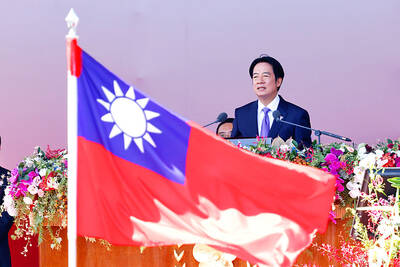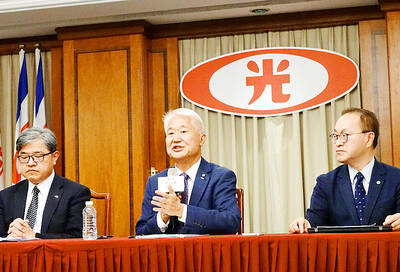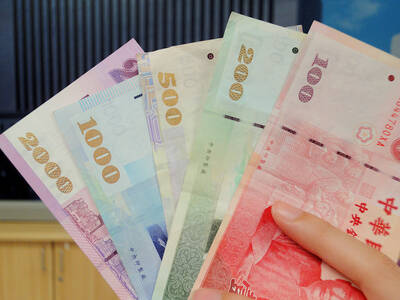Debate within the Democratic Progressive Party (DPP) about the so-called “1992 consensus” began right after DPP Chairperson Tsai Ing-wen’s (蔡英文) loss in the presidential election and has continued throughout the Lunar New Year break, as the party tries to determine if it should fine-tune its China policy to appeal to voters, DPP politicians and analysts said.
The “1992 consensus” was seen as one of the crucial factors in the Jan. 14 presidential election, which gave President Ma Ying-jeou (馬英九) of the Chinese Nationalist Party (KMT) a second four-year term.
The “1992 consensus” is only a part of cross-strait relations and it did not directly contribute to the DPP’s loss in the election, former DPP legislator Lin Cho-shui (林濁水) said.
The DPP should not accept the fictional consensus simply because of the loss, because that would only lend legitimacy to the KMT stance on the matter, Lin said.
However, the party does need to reconsider its position on the “1992 consensus” after weighing gains and losses in the three areas of sovereignty, security and trade, Lin said.
As for the “Taiwan Consensus,” an initiative proposed by Tsai, Lin said that it stressed the democratic nature of the process, but was less detailed in its content, which was the voters’ main concern about it.
“Tsai could easily have said that the content of the ‘Taiwan consensus’ means ‘The Republic of China [ROC] is Taiwan and Taiwan is the ROC’ — one of her major statements in the campaign. I have no idea why she did not make the connection,” he said.
Former DPP legislator Kuo Cheng-liang (郭正亮) was among those who said the DPP should accept the “1992 consensus” to at least some extent or find ways to work around the consensus, since the DPP has yet to propose any solution for engaging China without the “1992 consensus.”
The DPP must change its stance on cross-strait affairs because both China and the US favor the KMT’s approach, as shown by their preference for Ma in the presidential election, Kuo said.
Kuo said the DPP should review its policy on Taiwanese independence, its tolerance for the “one China with different interpretations” framework and whether to replace a “Taiwan consensus” with a “constitutional consensus.”
The party could also interpret the “1992 consensus” as “a platform to set aside disputes, without any timetable” to foster possible dialogue with Beijing, he said.
Former vice president Annette Lu (呂秀蓮) also labeled the “Taiwan consensus” as “weak and vague,” saying that the DPP’s “1999 Resolution on Taiwan’s Future,” which defines Taiwan as a sovereign country separate from China, while acknowledging the ROC as the country’s formal title, would be better for explaining the party’s China policy.
Regardless of what the DPP’s plan to deal with the “1992 consensus” is, the election should not be interpreted as “a victory and Taiwanese people’s endorsement of the consensus,” Soochow University professor Lo Chih-cheng (羅致政) said.
The “1992 consensus” is too weak to sustain bilateral engagement over the next four years and Beijing could step up its pressure for political negotiations, Lo said.
Tsai has not made any comments on the matter since the election. She has pledged to submit a complete review of the election campaign to the party before March 1, when her resignation as party chair takes effect.

People can preregister to receive their NT$10,000 (US$325) cash distributed from the central government on Nov. 5 after President William Lai (賴清德) yesterday signed the Special Budget for Strengthening Economic, Social and National Security Resilience, the Executive Yuan told a news conference last night. The special budget, passed by the Legislative Yuan on Friday last week with a cash handout budget of NT$236 billion, was officially submitted to the Executive Yuan and the Presidential Office yesterday afternoon. People can register through the official Web site at https://10000.gov.tw to have the funds deposited into their bank accounts, withdraw the funds at automated teller

PEACE AND STABILITY: Maintaining the cross-strait ‘status quo’ has long been the government’s position, the Ministry of Foreign Affairs said Taiwan is committed to maintaining the cross-strait “status quo” and seeks no escalation of tensions, the Ministry of Foreign Affairs (MOFA) said yesterday, rebutting a Time magazine opinion piece that described President William Lai (賴清德) as a “reckless leader.” The article, titled “The US Must Beware of Taiwan’s Reckless Leader,” was written by Lyle Goldstein, director of the Asia Program at the Washington-based Defense Priorities think tank. Goldstein wrote that Taiwan is “the world’s most dangerous flashpoint” amid ongoing conflicts in the Middle East and Russia’s invasion of Ukraine. He said that the situation in the Taiwan Strait has become less stable

CONCESSION: A Shin Kong official said that the firm was ‘willing to contribute’ to the nation, as the move would enable Nvidia Crop to build its headquarters in Taiwan Shin Kong Life Insurance Co (新光人壽) yesterday said it would relinquish land-use rights, or known as surface rights, for two plots in Taipei’s Beitou District (北投), paving the way for Nvidia Corp to expand its office footprint in Taiwan. The insurer said it made the decision “in the interest of the nation’s greater good” and would not seek compensation from taxpayers for potential future losses, calling the move a gesture to resolve a months-long impasse among the insurer, the Taipei City Government and the US chip giant. “The decision was made on the condition that the Taipei City Government reimburses the related

FRESH LOOK: A committee would gather expert and public input on the themes and visual motifs that would appear on the notes, the central bank governor said The central bank has launched a comprehensive redesign of New Taiwan dollar banknotes to enhance anti-counterfeiting measures, improve accessibility and align the bills with global sustainability standards, Governor Yang Chin-long (楊金龍) told a meeting of the legislature’s Finance Committee yesterday. The overhaul would affect all five denominations — NT$100, NT$200, NT$500, NT$1,000 and NT$2,000 notes — but not coins, Yang said. It would be the first major update to the banknotes in 24 years, as the current series, introduced in 2001, has remained in circulation amid rapid advances in printing technology and security standards. “Updating the notes is essential to safeguard the integrity